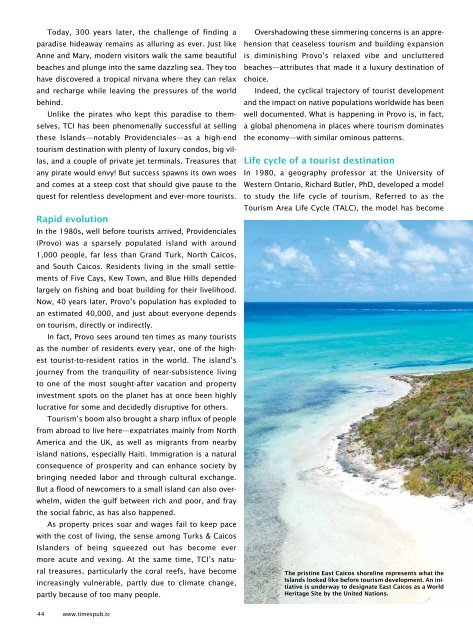Times of the Islands Winter 2023/24
Presents the "soul of the Turks & Caicos Islands" with in-depth features about local people, culture, history, environment, real estate, businesses, resorts, restaurants and activities.
Presents the "soul of the Turks & Caicos Islands" with in-depth features about local people, culture, history, environment, real estate, businesses, resorts, restaurants and activities.
You also want an ePaper? Increase the reach of your titles
YUMPU automatically turns print PDFs into web optimized ePapers that Google loves.
Today, 300 years later, <strong>the</strong> challenge <strong>of</strong> finding a<br />
paradise hideaway remains as alluring as ever. Just like<br />
Anne and Mary, modern visitors walk <strong>the</strong> same beautiful<br />
beaches and plunge into <strong>the</strong> same dazzling sea. They too<br />
have discovered a tropical nirvana where <strong>the</strong>y can relax<br />
and recharge while leaving <strong>the</strong> pressures <strong>of</strong> <strong>the</strong> world<br />
behind.<br />
Unlike <strong>the</strong> pirates who kept this paradise to <strong>the</strong>mselves,<br />
TCI has been phenomenally successful at selling<br />
<strong>the</strong>se <strong>Islands</strong>—notably Providenciales—as a high-end<br />
tourism destination with plenty <strong>of</strong> luxury condos, big villas,<br />
and a couple <strong>of</strong> private jet terminals. Treasures that<br />
any pirate would envy! But success spawns its own woes<br />
and comes at a steep cost that should give pause to <strong>the</strong><br />
quest for relentless development and ever-more tourists.<br />
Rapid evolution<br />
In <strong>the</strong> 1980s, well before tourists arrived, Providenciales<br />
(Provo) was a sparsely populated island with around<br />
1,000 people, far less than Grand Turk, North Caicos,<br />
and South Caicos. Residents living in <strong>the</strong> small settlements<br />
<strong>of</strong> Five Cays, Kew Town, and Blue Hills depended<br />
largely on fishing and boat building for <strong>the</strong>ir livelihood.<br />
Now, 40 years later, Provo’s population has exploded to<br />
an estimated 40,000, and just about everyone depends<br />
on tourism, directly or indirectly.<br />
In fact, Provo sees around ten times as many tourists<br />
as <strong>the</strong> number <strong>of</strong> residents every year, one <strong>of</strong> <strong>the</strong> highest<br />
tourist-to-resident ratios in <strong>the</strong> world. The island’s<br />
journey from <strong>the</strong> tranquility <strong>of</strong> near-subsistence living<br />
to one <strong>of</strong> <strong>the</strong> most sought-after vacation and property<br />
investment spots on <strong>the</strong> planet has at once been highly<br />
lucrative for some and decidedly disruptive for o<strong>the</strong>rs.<br />
Tourism’s boom also brought a sharp influx <strong>of</strong> people<br />
from abroad to live here—expatriates mainly from North<br />
America and <strong>the</strong> UK, as well as migrants from nearby<br />
island nations, especially Haiti. Immigration is a natural<br />
consequence <strong>of</strong> prosperity and can enhance society by<br />
bringing needed labor and through cultural exchange.<br />
But a flood <strong>of</strong> newcomers to a small island can also overwhelm,<br />
widen <strong>the</strong> gulf between rich and poor, and fray<br />
<strong>the</strong> social fabric, as has also happened.<br />
As property prices soar and wages fail to keep pace<br />
with <strong>the</strong> cost <strong>of</strong> living, <strong>the</strong> sense among Turks & Caicos<br />
Islanders <strong>of</strong> being squeezed out has become ever<br />
more acute and vexing. At <strong>the</strong> same time, TCI’s natural<br />
treasures, particularly <strong>the</strong> coral reefs, have become<br />
increasingly vulnerable, partly due to climate change,<br />
partly because <strong>of</strong> too many people.<br />
Overshadowing <strong>the</strong>se simmering concerns is an apprehension<br />
that ceaseless tourism and building expansion<br />
is diminishing Provo’s relaxed vibe and uncluttered<br />
beaches—attributes that made it a luxury destination <strong>of</strong><br />
choice.<br />
Indeed, <strong>the</strong> cyclical trajectory <strong>of</strong> tourist development<br />
and <strong>the</strong> impact on native populations worldwide has been<br />
well documented. What is happening in Provo is, in fact,<br />
a global phenomena in places where tourism dominates<br />
<strong>the</strong> economy—with similar ominous patterns.<br />
Life cycle <strong>of</strong> a tourist destination<br />
In 1980, a geography pr<strong>of</strong>essor at <strong>the</strong> University <strong>of</strong><br />
Western Ontario, Richard Butler, PhD, developed a model<br />
to study <strong>the</strong> life cycle <strong>of</strong> tourism. Referred to as <strong>the</strong><br />
Tourism Area Life Cycle (TALC), <strong>the</strong> model has become<br />
The pristine East Caicos shoreline represents what <strong>the</strong><br />
<strong>Islands</strong> looked like before tourism development. An initiative<br />
is underway to designate East Caicos as a World<br />
Heritage Site by <strong>the</strong> United Nations.<br />
44 www.timespub.tc
















